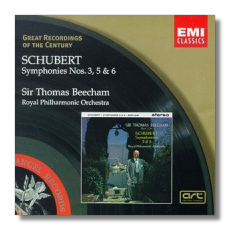
The Internet's Premier Classical Music Source
Related Links
- Schubert Reviews
- Latest Reviews
- More Reviews
-
By Composer
-
Collections
DVD & Blu-ray
Books
Concert Reviews
Articles/Interviews
Software
Audio
Search Amazon
Recommended Links
Site News
 CD Review
CD Review
Franz Schubert

Symphonies
- Symphony #3 in D Major, D. 200 (1815)
- Symphony #5, D. 485 (1816)
- Symphony #6 in C Major, D. 589 (1818)
Royal Philharmonic Orchestra/Thomas Beecham
EMI 66999
This is a story about duplication of recordings. Many of us collectors often face the question, "Why do you need so many recordings of the same piece?" In fact, many of us sometimes pose the question to ourselves. Let me give you one reason.
I had the original LP of these recordings, which contained the Third and Fifth Symphonies. I got it at Liberty Records, in Ann Arbor, as an import back in the late 70s. I was new to classical music, everything was new to my ears. I was bowled over by the experience. Later I got the first CD incarnation, which had Symphony #6 added to the contents (EMI 69750). Well, as with many early CDs, the sound was shrill at points and the bass line thin. I was disappointed. So, when I read that EMI was issuing the same symphonies in their "Great Recordings of the Century" line, with the latest technological improvements, I was anxious to hear it. The midrange is now warm, the bass line richer. This is how all recordings should sound on CD. Now, this is not the reason for duplication, this is a reason for replacement.
As I said, this was my first introduction to these works. Over the years I have had others and, just before this disc arrived for review, I got a Penguin Classics CD with István Kertész conducting the VPO in Schubert's 9th and 5th. I confess I got the disc because I wanted another "Great" in my collection. I had hoped the coupling would be the "Unfinished" but you know what they say about half-a-loaf. "The Great" is just that. Then I turned to the 5th. As I played it I kept feeling that something was missing. I couldn't put my finger on it and wondered if it was just that I didn't like the piece. Then this EMI disc arrived. You and I have both read reviews where the writer talks about a recording having "character". I used to wonder what they meant by this. Well, listen to Beecham and Kertész and you will know what is meant. Beecham has character in spades. In the Fifth Symphony the whole band sounds like they're just having a great time, just listen to the solo flute in the first movement. I find myself moving to the music. The same can be said for the other two pieces. It all has a Schubertian song-like quality to it. Much as I like much of what Kertész recorded, this Fifth is flatfooted. There's no singing line.
Okay, now back to the question I posed in the beginning. An important reason for duplication is the need for a musical "dictionary" for reference. I now know what a recording having "character" means. In the case of music, only operational definitions can have meaning. So, I keep these recordings to have access to my musical "dictionary" or "map". That is, we collectors have to have these recordings as instances of the concept. Just as a dictionary of words might offer various "meanings" of a word, so does each recording. That is, in some sense there is no real duplication in collecting recordings. Every recording, good or bad, helps us expand our knowledge and appreciation of a piece of music. I think it is self-evident that learning is good, getting dumber is not.
Buy Beecham!
Copyright © 1999, Robert Stumpf II


















